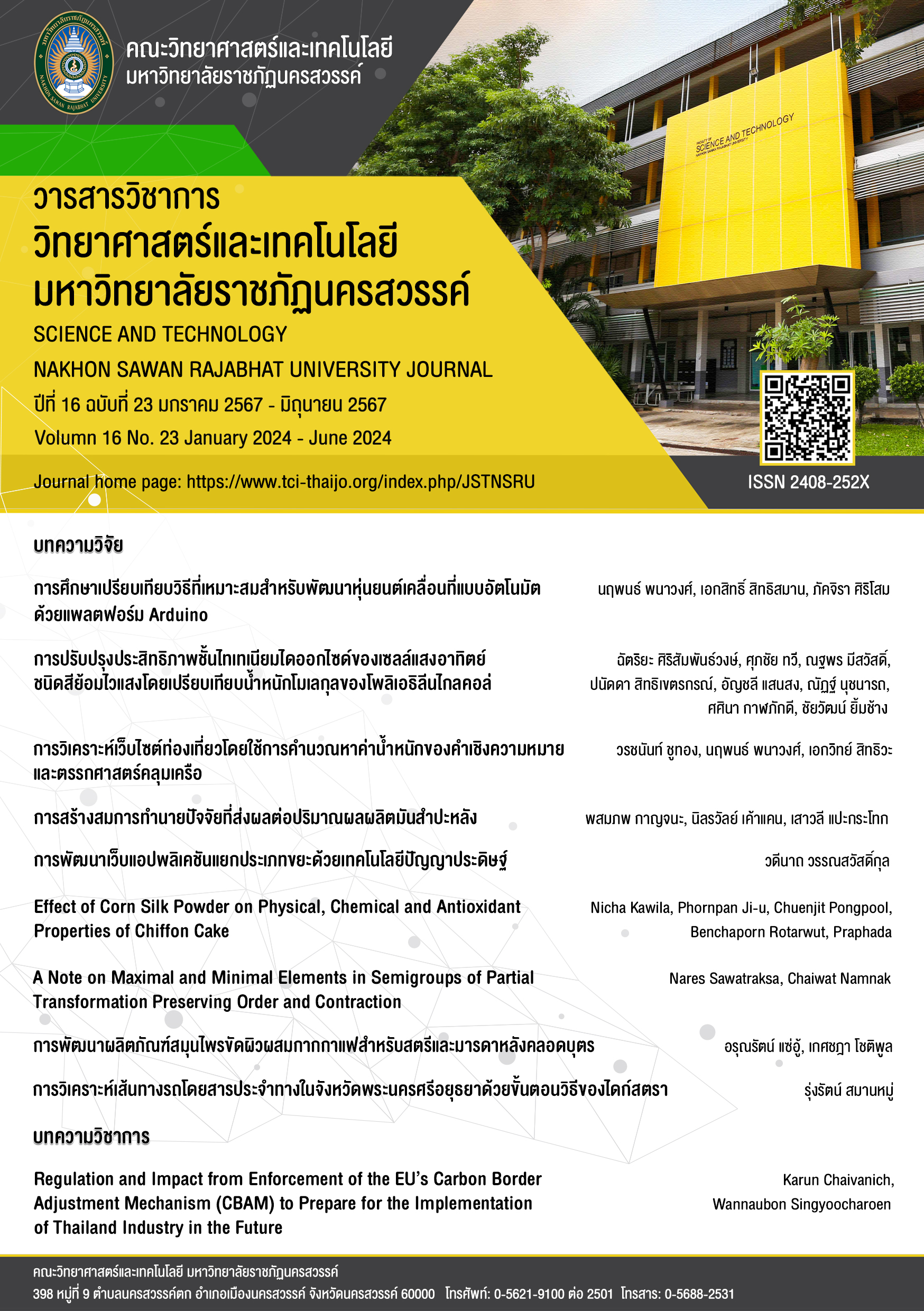Effect of Corn Silk on Physical, Chemical and Antioxidant Properties of Chiffon Cake
Main Article Content
Abstract
Corn silk, the female flower stigma of maize (Zea mays L.), is considered as a waste in corn related processing food productions. This research aims to fortify the different levels (0, 10, 20 and 30% w/w) to chiffon cakes. The corn silk powder was prepared with minced the dried sweet corn silk with the hammer mill. The chiffon cakes were evaluated the physical and chemical properties. The viscosity and pH of cake batters were not significantly different. The pH of cake batter declined with an increase in corn silk powder level. Significant increasing of hardness, gumminess, chewiness were found when increasing the percentage of corn silk powder. The total phenolics compound of chiffon cake significantly increased with 10, 20 and 30% fortification with corn silk powder compared to the control. The highest amount of total phenolics compound was found in cake prepared with 30% fortification of cake flour with corn silk powder. These findings indicated that corn silk powder could be a potential source for health due to effective antioxidant properties.
Article Details

This work is licensed under a Creative Commons Attribution-NonCommercial-NoDerivatives 4.0 International License.
References
Aqil, F., Ahmad, I., & Mehmood, Z. (2006). Antioxidant and Free Radical Scavenging Properties of Twelve Traditionally Used Indian Medicinal Plants. Turkish Journal of Biology, 30(3), 177-183. https://journals.tubitak.gov.tr/biology/vol30/iss3/11.
Aukkanit, N., Kemngoen, T., & Ponharn, N. (2015). Utilization of corn silk in low fat meatballs and its characteristics. Procedia - Social and Behavioral Sciences, 197, 1403-1410. https://doi.org/10.1016/j.sbspro.2015.07.086
Hasanudin, K., Hashim, P., & Mustafa, S. (2012). Corn Silk (Stigma Maydis) in Healthcare: A Phytochemical and Pharmacological Review. Molecules, 17(8), 9697-9715. https://doi.org/10.3390/molecules17089697
Kawila, N. (2022). The effect of drying processing on physico-chemical properties in corn silks. Proceedings of The 24th Food Innovation Asia Conference 2022 (pp. 97-102). Thailand.
Kim, J.H., Lee, H.J., Lee, H.S., Lim, E.J., Imm, J.Y., & Suh, H.J. (2012). Physical and sensory characteristics of fibre-enriched sponge cakes made with Opuntia humifusa. LWT, 47(2), 478-484. https://doi.org/10.1016/j.lwt.2012.02.011
Lee, C.C., & Lin, S.D. (2008). Effect of GABA Tea on Quality Characteristics of Chiffon Cake. Cereal Chemistry, 85(1), 31-38. https://doi.org/10.1094/CCHEM-85-1-0031
Lu, J., Zhao, H., Chen, J., Fan, W., Dong, J., Kong, W., Sun, J., Cao, Y., & Cai, G. (2007). Evolution of Phenolic Compounds and Antioxidant Activity during Malting. Journal of Agricultural and Food Chemistry, 55(26), 10994-11001. https://doi.org/10.1021/jf0722710
Lu, T.M., Lee, C.C., Mau, J.J., & Lin, S.D. (2010). Quality and antioxidant property of green tea sponge cake. Food Chemistry, 119(3), 1090-1095. https://doi.org/10.1016/j.foodchem.2009.08.015
Maksimovic, Z., Malencic, D., & Kovacevic, N. (2005). Polyphenol contents and antioxidant activity of Maydis stigma extracts. Bioresource Technology, 96(8): 873-877. https://doi.org/10.1016/j.biortech.2004.09.006
Mau, J.L., Lu, T.M., Lee, C.C., Lin, L.Y., Cheng, C.H., & Lin, S.D. (2015). Physicochemical, Antioxidant and Sensory Characteristics of Chiffon Cakes Fortified with Various Tea Powders. Journal of Food Processing and Preservation, 39, 443-450. https://doi.org/10.1111/jfpp.12249
Mau, J.L., Lee, C.C., Chen, Y.P., & Lin, S.D. (2017). Physicochemical, antioxidant and sensory characteristics of chiffon cake prepared with black rice as replacement for wheat flour. LWT-Food Science and Technology, 75, 434-439. https://doi.org/10.1016/j.lwt.2016.09.019
Nurhanan, A.R., Wanrosli, W. I., & Mohsin, S.S.J., (2012). Total Polyphenol Content and Free Radical Scavenging Activity of Cornsilk (Zea mays hairs). Sains Malaysiana, 41(10), 1217-1221. https://www.researchgate.net/publication/285794785
Office of Agricultural Economics. (2022). Data of agricultural economics. http://www.oae.go.th.
Pasukamonset, P., Pumalee, T., Sanguansuk, N., Chumyen, C., Wongvasu, P., Adisakwattana, S., & Ngamukote, S. (2018). Physicochemical, antioxidant and sensory characteristics of sponge cakes fortified with Clitoria ternatea extract. Journal of Food Science Technology, 55(8), 2881–2889. https://doi.org/10.1007/s13197-018-3204-0
Popovska, O. (2022). Determination of some flour characteristic. European Fournal of Agriculture and Food Sciences, 5(4), 8-12. https://doi.org/10.24018/ejfood.2023.5.4.683.
Sarepoua, E., Tangwongchai, R., Suriharn, B., & Lertrat, K., (2015). Influence of variety and harvest maturity on phytochemical content in corn silk. Food Chemistry, 169, 424-429. https://doi.org/10.1016/j.foodchem.2014.07.136
Şeker, İ.T., Ertop, M.H., & Hayta, M. (2016). Physicochemical and bioactive properties of cakes incorporated with gilaburu fruit (Viburnum opulus) pomace. Quality Assurance and Safety of Crops & Foods, 8(2), 261–266. https://doi.org/10.3920/QAS2014.0542
Senphan, T., Yakong, N., Aurtae, Keawalin., Songchanthuek, S., Choommongkol, V., Fuangpaiboon, N., Phing, P.L., & Yarnpakdee, S. (2019). Comparative studies on chemical composition and antioxidant activity of corn silk from two varieties of sweet corn and purple waxy corn as influenced by drying methods. Food and Applied Bioscience Journal, 7(3), 64-80. https://li01.tci-thaijo.org/index.php/fabjournal/article/view/225020/161784


